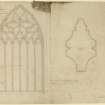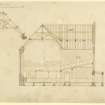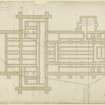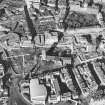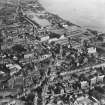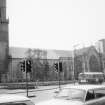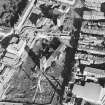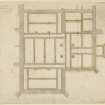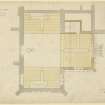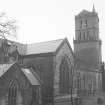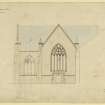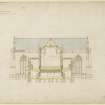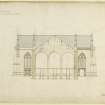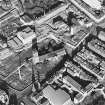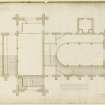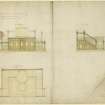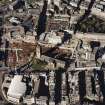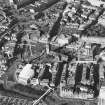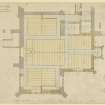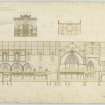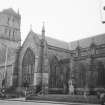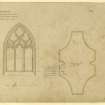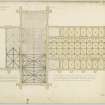Dundee, Nethergate, City Churches, Old St Paul's And St David's Church
Church (19th Century)
Site Name Dundee, Nethergate, City Churches, Old St Paul's And St David's Church
Classification Church (19th Century)
Alternative Name(s) Cross Church; Mary Slessor Centre; South Church
Canmore ID 185631
Site Number NO43SW 358
NGR NO 40166 30128
Datum OSGB36 - NGR
Permalink http://canmore.org.uk/site/185631
- Council Dundee, City Of
- Parish Dundee (Dundee, City Of)
- Former Region Tayside
- Former District City Of Dundee
- Former County Angus
NMRS REFERENCE:
Dundee, Nethergate, City Churches, Old St Paul's & St David's or South Church.
1841-2
Architect: David Bryce to plans of:
Wm Burn 1847 (1842 designs)
Designs built on site of old transepts - also known as South & Cross churches later.
Dundee, Nethergate, City Churches.
Architect: Samuel Bell 1788 St Clement's
William Burn 1828 Restoration
William Burn 1841 Restoration after fire - Old St Paul's & St David's
St Mary's Church
NMRS/Simpson & Brown photographs.
Box 8 album no 117
1989 exterior and many interior views.
Excavation (1992 - 1993)
Excavation and a watching brief in 1992-3 by SUAT Ltd during environmental improvements in the area of the City Churches revealed a ditch, which had been re-cut, extending southwards from the church. It was sealed beneath a medieval graveyard from which remains of 130 skeletons were recovered, along with a large quantity of disarticulated human bone. A stone box drain for the 19th century St Mary's parish church was cut into the graveyard.
The 1992-1993 excavation trenches, A to H, were located to the S of the City Churches, with one exception which was situated in front of the W door. Excavation was confined to only those areas were wall foundations, drainage pipe trenches or other groundworks disturbed the graveyard soil. As well as the trenches dug a watching brief was maintained on other groundworks in the precinct which led to a further trench, H, in a area of interest outside the W door to the tower. [1]
The main objective of the excavation was to record and remove the human remains that were threatened by deep foundation trenches and new drainage tracks. A further objective was to resolve the question as to whether the burials were related to the massacre in 1651 or were earlier medieval burials. It was hoped that evidence of structures would also be found, as Crawfurd's 18th century maps showed buildings along the Nethergate, as well as wider transepts on the church. [2]
The excavation produced firm evidence for a graveyard around the south and west sides of the church building, in areas once thought to have been devoid of burials. A total of 130 skeletons were excavated along with a large quantity of disarticulated human bone. Intercutting burials in each of the examined areas support the conclusion that this graveyard was used over a considerable number of years, and that there was no sign of a mass grave from General Monck's massacre in 1651. All ages were represented, as were both sexes. Areas of greater and lesser density of burials were also identified, although it is difficult to tell if this represents the use of individual layers. Preservation, in general, was poor and coffins were inferred with corroded nails found with some of the burials. Generally the coffins seem to be late in the burial sequence, perhaps indicating a change in burial practice during the use of the cemetery.
Dating the cemetery accurately is difficult, but it is apparently disused by the time that a stone culvert is inserted. This culvert was certainly present by 1841, as it was used for drainage by the architects of the 19th century rebuilding of the chancel and transepts. An earlier date for this drain is possible, as a similar one was encountered during construction south of the late 18th century nave.
The presence of burials cut by the steeple also indicates that at least one part of the cemetery had come in and gone out of use by the end of the 15th century. This agrees with the pottery recovered from sealed graves, which is 12th to 15th century in date.
The earliest date for burial is also in doubt. The only feature predating the graveyard has no dating evidence in it, and the historical evidence is sparse. This early ditch, with its possible gravel bank, may have formed part of the early town defences, and would almost certainly had predated the founding of the building that currently crosses its projected line. If projected southwards, it would have given shelter to Spalding's Wynd, which was formerly known as Abbot's Wynd. As such, its use as a town defence prior to Earl David's founding of a church in the late 12th century is not unreasonable. Further work in the Nethergate area will be needed to provide a more substantial answer.
As for the survival of archaeological deposits around the remainder of the church precinct, the results of watching briefs were poor. The pipe trench running down the west side of the church produced nothing but natural gravel and brick basements from the former South Lindsey St.
Information from SUAT
Archaeological Evaluation (10 May 2011)
During renovation works undertaken within the interior of The Steeple Church in Dundee, a significant quantity of human remains were truncated and recovered by the contractor prior to contacting the police. Located within a working Church, the project was exempt from the planning process through eccleciastical exemption. Scots Law protects against the mistreatment of human remains and Addyman Archaeology undertook an assessment/evaluation of the site in order to understand the extent of the site and the damage caused. The evaluation showed the excavations within the Trial Pit had truncated a minimum of one inhumation with a quantity of charnel from at least a further two individuals. Also revealed was a number of femus from a minimum of six individuals recovered by the Church during excavations in the Boiler Room. Of particular note amongst these was two femurs which showed the short, bowed bone-shafts and normal-sized bone ends typical of achondroplasia, the most common form of congenital dwarfism.
Information from Oasis (addymana1-113706) 9 January 2014
Excavation (12 September 2011 - 8 March 2012)
In May 2011 Addyman Archaeology were contacted to undertake recording and recovery of a significant quantity of human remains encountered during work in the Steeple Church in Dundee. Under the guidance of Simpson and Brown Architects the Church is being renovated and a new wall is to be constructed along a N-S axis at the E end of the sanctuary. In advance of this development, two engineering test pits were excavated - it was in the second of these that two articulated skeletons were encountered. In addition to the remains recovered from in and around the test pit, work undertaken previously in the area of the boiler room had revealed a large quantity of human bones. These were collected and the area of the boiler room assessed. The discovery and assessment of these remains led to the appointment of Addyman Archaeology to oversee the archaeological mitigation of the development and undertake all ground breaking works during the project. Two areas were identified for excavation. The first in the area currently occupied by offices to the E of the Sanctuary was excavated prior to the insertion of a lift shaft and whilst archaeological features and human bone were encountered, no inhumations were disturbed during this work. However, excavation of a large, N-S aligned foundation trench across the E end of the sanctuary uncovered 15 in situ skeletons, all of which were recorded and reburied as close to their point of origin as possible.
Information from Oasis (addymana1-122656) 9 January 2014





















































